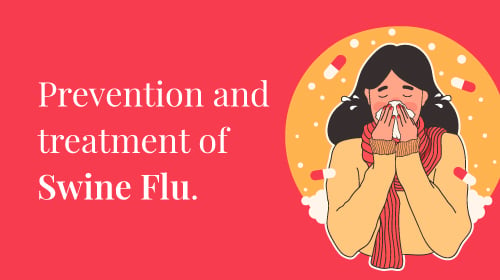Swine flu: Causes, symptoms, and treatment
October 22, 2022

The H1N1 virus, usually known as swine flu, is a relatively new form of influenza that triggers symptoms similar to those of the common flu. It originates in pigs but is primarily transmitted from person to person.
Swine flu grabbed news in 2009 when it was found in humans and quickly spread to become a pandemic. Pandemics are infectious illnesses that impact individuals all over the world or on numerous continents at the same time.
Contents
- Symptoms of swine flu
- Causes of swine flu
- Risk factors for swine flu
- Diagnosis of swine flu
- Vaccine for swine flu
- Treatment for swine flu
- Swine flu symptoms relief
- Preventing Swine flu
- Lifestyle remedies for swine fluLifestyle remedies for swine flu
- When to see a swine flu specialist
- People also ask
H1N1 is highly infectious, as are other forms of the flu, enabling it to spread fast from one person to another. For example, a mere sneeze may transmit thousands of germs across the air. In addition, the virus may persist on surfaces such as tables and doorknobs, ready to be picked.
The easiest way to cope with swine flu is to avoid it. Hand sanitisation is critical for preventing the virus’s transmission. In addition, staying away from sick persons will aid in the prevention of person-to-person transmission.
Symptoms of swine flu
Swine flu symptoms are pretty similar to those of ordinary influenza. They are as follows:
- Chills
- Fever
- Coughing
- Sore throat
- Runny or stuffy nose
- Body aches
- Fatigue
- Diarrhoea
- Nausea and vomiting
Causes of swine flu
Swine flu is caused by an influenza virus subtype that commonly exclusively affects pigs. Unlike typhus, where lice or ticks can spread, transmission is mainly from person to person rather than from animal to person.
Swine flu cannot be contracted by eating adequately cooked pig products. Swine flu is highly infectious. The illness is transmitted by saliva and mucus particles. People can spread it by doing the following:
- Sneezing
- sneezing
- Touching their eyes and nose after touching a germ-infested surface
Risk factors for swine flu
When it initially appeared, swine flu was more frequent in children five and older and young adults. This was surprising because typical flu virus infections are associated with an increased risk of complications in elderly persons or children. Today, the risk factors for swine flu are the same as for any other form of the flu. You are most vulnerable if you spend some time in an area with a high concentration of people afflicted with swine flu.
When infected with swine flu, certain people are more likely to become critically sick. Among these groupings are:
- Adults over age 65
- Children under five years old
- Young adults and children under age 19 who are receiving long-term aspirin (Bufferin) therapy
- People with compromised immune systems (due to a disease such as AIDS)
- Pregnant women
- People with chronic illnesses such as asthma, heart disease, diabetes mellitus, or neuromuscular disease.
Diagnosis of swine flu
A doctor can diagnose you by taking a fluid sample from your body. Your doctor or nurse may swab your nose or throat to get a piece. The swab will be tested using several genetic and scientific techniques to determine the precise type of virus.
Vaccine for swine flu
Following the 2009 H1N1 outbreak, scientists created a vaccine to protect people from the virus. Since then, H1N1 protection has been included in the usual seasonal flu vaccination.
Every year, specialists attempt to anticipate which flu virus strains will be prevalent throughout the flu season, which typically peaks in the winter. Then, they create vaccinations based on the sorts of infections that are most likely to arise.
Treatment for swine flu
The majority of swine flu cases do not necessitate medicine. Unless you risk developing medical issues from the flu, you do not need to consult a doctor. However, it would help if you concentrated on treating your symptoms and limiting the spread of H1N1.
The antiviral medications oseltamivir (Tamiflu) and zanamivir are indicated for treating swine flu (Relenza). However, because flu viruses might resist these medications, they are frequently reserved for those at high risk of flu complications. Otherwise, healthy people who contract swine flu will be capable of fighting it independently.
Most people recover from H1N1 without requiring substantial medical treatment. However, in rare circumstances, a doctor could prescribe an antiviral medicine. These medications can lessen the length and intensity of symptoms.
People may require these medications immediately if they:
- suffer from severe symptoms or consequences
- are hospitalised face an increased risk of complications
Swine flu symptoms relief
Methods for treating swine flu symptoms are similar to those used for ordinary flu:
- Get enough rest. This will allow your immune system to concentrate on battling the illness.
- To avoid dehydration, consume a lot of water and other liquids. Soup and clear liquids can assist your body recover lost nutrients.
- Take over-the-counter pain medications for headaches and sore throats.
Preventing Swine flu
The easiest way to avoid swine flu is to obtain a flu shot yearly. Other simple strategies to prevent swine flu include:
- Wash your hands often with soap or hand sanitiser, and avoid your nose, mouth, or eyes altogether. (The virus may live on surfaces such as phones and tables.)
- If you are sick, you should remain away from work or school.
- Avoiding mass gatherings during swine flu season
Lifestyle remedies for swine flu
- Using over-the-counter remedies
- Washing hands regularly
- Getting plenty of sleep
- Exercising often
- Managing stress
- Drinking liquids
- Eating a balanced diet
- Avoiding being close to someone with flu symptoms
- Not touching surfaces that may have the virus
When to see a swine flu specialist
Get medical attention right once if you exhibit severe flu symptoms. Emergency signs and symptoms may include: Chest pain, shortness of breath, or difficulty breathing.
People also ask
1. What are the main symptoms of swine flu?
Swine flu symptoms are pretty similar to those of ordinary influenza. They are as follows:
- Chills
- Fever
- Coughing
- Sore throat
- Runny or stuffy nose
- Body aches
- Fatigue
- Diarrhoea
- Nausea and vomiting
2. How long does swine flu last?
The symptoms are similar to those of other kinds of ordinary flu. They are often moderate and last 1 to 2 weeks. However, like other forms of flu, some individuals are more susceptible to severe diseases, especially those with underlying health issues.
3.Can swine flu cause death?
In 2020, India recorded around 2,752 instances of swine flu, widely termed influenza A (H1N1), with 44 fatalities. In 2015, the country saw an outbreak of this illness, with over 42 thousand cases and 2,990 deaths.
The influenza A (H1N1) virus strain was initially identified in 1919, but the World Health Organization proclaimed it a global pandemic in 2009, which lasted until August 2010 worldwide.








